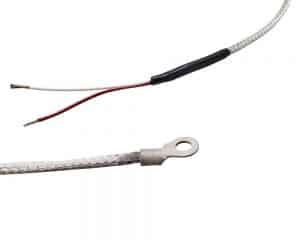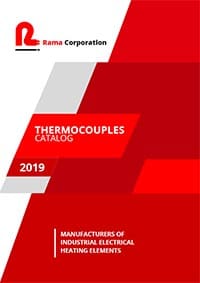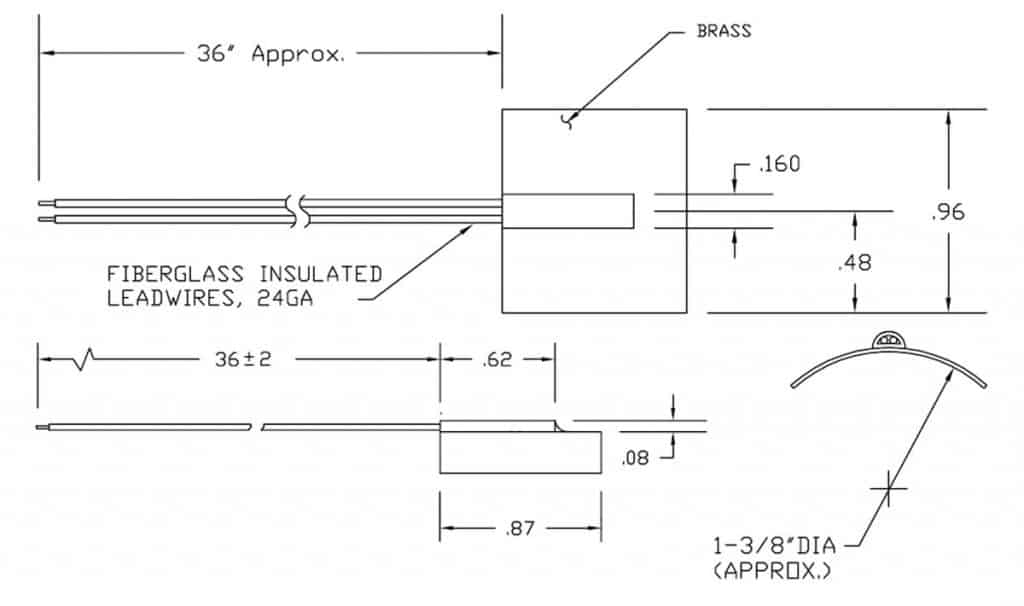Rama Corporation offers a great selection of thermocouples to meet just about every need. We understand how reliant we are on thermocouples today and the quality expectations. Thermocouples are used in a variety of applications and as safety measures as well. It is important to have a good quality thermocouple manufacturer that provides a large selection to get the right product for each and every application. At Rama Corporation we offer just that. Take a look at our thermocouple selection. If you have any questions, just ask, our trained technicians are ready to help.
Rama Corp Thermocouple
manufacturer
About Thermocouples
Rama Corporation makes both on the shelf heating elements as well as custom options. Do you have something that simply cannot find anywhere else? We can make it for you. Our engineering team can take your concept and make it a reality from the prototype to the full production.
Our friendly staff can go over any concerns you might have and we are available when you are. We are right here in the United States, which makes communication and doing business so much easier.

THERMOCOUPLE Rama Corporation TC6
Thermocouples are used to measure temperature. They are a sensor that consists of two different types of metals. When these metals are heated and cooled voltage is created. This voltage correlates back to the temperature. They are simple, cost-effective, robust temperature sensors that are used in a wide range of temperature measuring processes. And, they are made in a variety of shapes and sizes to meet the needs of the various applications.
Thermocouples are made up of two different types of dissimilar metals that are joined together. A thermoelectric circuit is made when the end is heated. This is called Seebeck Voltage. Seebeck Voltage was named after the scientist that discovered this effect, Thomas Seebeck. It happens when two different metals are in close proximity of each other and generates an electrical current in proportion to the heat they sense. These metals will react to the heat and this reaction will produce a voltage which is the Seebeck Voltage.
Thomas Seebeck, a German physician, discovered that if you link two different metals together at one end there is a circuit formed. This circuit is called an electromagnetic field (EMF). The energy produced in this circuit is called the Seebeck Effect. From this discovery, the first batteries were born.
Thomas Seebeck discovered that if he took two metals of different temperatures and made a series circuit by joining them together at one end and measuring at the other, that voltage was created. It didn’t seem to matter the shape of the metal either. The larger difference in the temperature the more voltage was created.
Thermocouples are made of different types of metals that operate on different calibrations. The most common thermocouple type is “Base metal” which are in the types of J, K, T, E and N. But, there are higher calibrations such as R, S, C, and GB as well.
Each of the calibrations has a different temperature range. However, the ranges max out from the diameter of the lead wire as well. The J Calibration is 0°C – 750°C, the K is -200°C to 1250°C, E is -200°C to 900°C and T is -250°C to 350°C. Because of the wide ranges of temperatures they can be used in a variety of applications. There are many uses for thermocouples and various styles and designs as well.
There are three basic types of junctions used in thermocouples. These are the grounded, exposed and ungrounded. The tip of the probe and how the wires are in the probe determine this.
If the wires are attached at the very tip, it is a grounded probe. This means that the wires are physically attached at the tip of the probe wall. The results of this style will mean that the heat from the outside will be instantly transferred to the thermocouples ground wires.
And an unground style means that the wires are embedded into the probe a bit deeper. This means that the thermocouple has a bit of electrical isolation and the response to temperature change is slower as well. The wires are not touching the tip of the probe at all. This will cause a bit of delay as the probe will have to heat up before it is sensed by the thermocouple.
The exposed style means that the thermocouple wires are on the outside of the probe and not related to the probe in any fashion. It is completely exposed to the outside environment. This offers the very best response from the thermocouple but is limited to its uses as it’s completely exposed.
Each style of the thermocouple probe has its uses. The grounded style is used in measuring the static or flowing corrosive gas or liquid temperatures for high-pressure applications. The junction of the thermocouple to the probe allows it to have been rigidity and longer life. But, it also has a better response time than that of the ungrounded type.
An ungrounded type of thermocouple probe is used when the thermocouple needs protection from a corrosive environment. It is embedded into the probe where it is protected from the outside elements. Although, it has a slower reaction time to the outside temperatures this is necessary in some cases.
The exposed probe is used when the material being measured is not corrosive in any way, whether it be gas or liquid. This offers the fastest response time available as the thermocouple is exposed at the very end.
Surface Washer Thermocouple Type TC6
Non-Insulated Ring Terminal
- Available in standard or heavy duty
- Available in a variety of gauges per customer request
- 20 gauge high temperature fiberglass thermocouple wires
For non-standard gauges contact vendor
Type ‘J’ or Type ‘K’, For non-standard types contact vendor
304 S/S Braid

There are different types of temperature sensors as well. There are the beaded weld, the probe, surface probe.
The most simple type of thermocouple sensor is the beaded wire. This is when two wires are welded together to make a bead at the end. It takes up very little room and is quick to measure. It is limited as the thermocouple is exposed to the outside elements. Which means it cannot be used in applications where the beaded tip will be corroded in any way, or it will give off false readings. They are a great choice when trying to measure the temperature of gas with their fast response times.
A probe style is a metallic tube that houses the thermocouple. The wall or sheath of the tube is typically made of stainless steel because of its chemical makeup and broad chemical compatibility. For much higher temperature materials, an exotic sheath is used. This probe style is where the various thermocouple types are used such as the grounded, ungrounded and exposed. the sheath quite often delivers the thermocouple to the location it needs to be and protects the wires. But, the exposure of the thermocouple is important to how it is used. See above for the various styles and recommendations.
Surface Probe measures the surface temperature of a solid surface. In order to ensure that the surface probe gets an accurate temperature reading the surface has to fully touch the surface probe. This style is not ideal for rigid surfaces as most thermocouples are made with pliable metals. This style of thermocouple can be made with a rotating surface which makes it perfect to measure the temperature of a moving surface.
It is a safety device that detects whether a pilot light is on or not. It is placed near the pilot light flame and connects to your furnace’s gas valve. When the pilot light is lite the gas line will remain open, but when it’s out the heat will cool off and the gas line will be closed. This is a safety mechanism on gas furnaces. If this mechanism was not on the furnace and the pilot light went out and all of a sudden came back, the room could explode.
The thermocouple temperature sensor should not be confused with a thermistor. Thermistors are much more accurate with the temperatures and can be dialed in more. However, thermocouples can be used for a wide range of applications such as the furnace example explained earlier. These temperature sensing devices are connected at one end. Thermistors are used when even the slightest of temperature changes need to be detected. While thermocouples are more for the broad range applications. There are similarities as well as differences from thermistors to thermocouples. Both are used in measuring temperatures.
There are different types of temperature sensors on the market today. These include RTD’s (Resistance temperature detectors), thermocouples, infrared sensors, thermistors, and semiconductor sensors. With each device comes a different set of parameters, styles, and types.
Temperature sensors are used to gather information and convert this information into an understandable format for a device or observer. They are used in a variety of applications as food processing, medical devices, chemical handling, under the hood in your car, HVAC systems, control systems, thermostats and more. The most common of these temperature sensors is a thermometer which is used to measure the temperature of a particularly solid, liquid or gas. The most common temperature sensor is the Thermocouple as it is very rugged, inexpensive and gets the job done. It’s there for the long haul and is simple to use and install. There is a wide range of applications that a thermocouple can be used for.
Resistor Temperature Detector (RTD) is one of the most accurate of the temperature sensors. The resistance is proportional to the temperature. It is usually made from nickel, platinum and copper metals. And has a wide range of temperature capabilities. However, the RTD does produce some of its own heat which can cause inaccurate readings. There are different types of RTD’s which are 2 wired, 3 wired and 4 wired.
Thermistors are another heat sensing device. They are relatively inexpensive and are also easy to use. Thermistors work as they change their resistance as the temperature change. And, most have a negative temperature coefficient. This means that when the temperature increases the resistance decreases. Thermistors have a higher sensitivity than RTD’s.
Thermometers are devices used to measure the temperature of a liquid, gas or solid. The name thermometer comes from the word thermo which means heat and meter which means measure. There is liquid inside that when heated expands up the tiny tube to measure the external heat. Typically the outer portion is made of glass and has lines to help you measure the heat which is recorded in Fahrenheit, Kelvin or Celsius.
Semiconductor Sensors are devices that are also temperature sensors. These sensors are much more costly than other options. It measures the change of an event and responds with a certain output. This output could be chemical, mechanical, radiant, magnetic, or thermal. The output is usually an electrical signal.
Thermocouple Sensor
Thermocouple Applications
- Thermocouples are used in a variety of places in the home, car, and industry. They are used to sense temperature and can be used for safety switches for pilot lights to monitoring the temperature of a batch of molten metal. They are used in chemical and petroleum plants. And, used in thermostats for your office, home or business. They are used under the hood for safety switches as well as t diagnostic testing instruments. They are great for pasteurization and food thermometers as well. Meat thermometers are a great example of where they are used in your kitchen. Wherever you need to measure temperature, you will most likely find a thermocouple.
Thermocouples and RTD’s
- Thermocouples can measure the differences in temperature pretty accurately and inexpensively. But, they are not as accurate as RTD’s (Resistance Temperature Detectors) or Thermistors. RTD’s are not as rugged as a thermocouple but do offer a wide range of accuracy and are fairly inexpensive as well. RTD’s use electricity to measure current, so they can heat themselves up and give off false readings. Thermistors are more accurate than thermocouples or RTDs but are much more limited on their temperature range. And, thermistors are also subject to self-heating. Infrared sensors are a great option for higher temperature applications. And, infrared sensors do not have to touch whatever it is they are measuring. However, infrared is not as accurate as the other options as it can be affected by surface heat.
Thermocouple Suppliers
- Rama Corporation has been in the heating element supply business for over 70 years! We offer a large variety of thermocouple's ready to supply your warehouse. Are you a distributor? We work with many distributors across the globe to keep their stocks levels at adequate levels. If you are interested in becoming a distributor or thermocouple supplier for Rama Corporation please visit us at sales@ramacorporation.com

Contact
RAMA COrp
- sales@ramacorporation.com
- (800) 472-5670
- Mon - Fri (6AM - 3PM)
- 600 West Esplanade Ave, San Jacinto CA.








